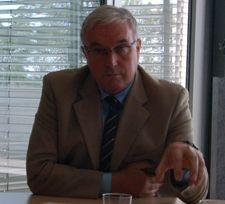AIGLE, Switzerland (BRAIN)—Cycling’s governing body opened its Swiss headquarters to a small group of trade and consumer journalists this week as it looks to improve its image and build a stronger relationship with the industry.
Union Cycliste Internationale (UCI) president Pat McQuaid welcomed the group of five journalists from Denmark, Taiwan, Germany, the U.K. and the U.S. for a two-day visit at the UCI’s $26 million headquarters set against the backdrop of the towering Alps near Lake Geneva.
The agenda included face time with McQuaid and Julien Carron, the technical coordinator in charge of the UCI’s new stickering program for frames and forks, a tour of the UCI and its World Cycling Center and riding on the center’s 250-meter velodrome, the training ground for athletes from all over the world.
A second media visit is scheduled next month.
The invites, as well as the UCI’s recent hiring of a third-party public relations company, it part of its strategy to communicate better with the industry it governs.
Often, its decisions are misinterpreted and the UCI needs to work at better explaining itself, McQuaid said.
“We’re all in the same boat. We’re in the same industry so to speak and we all have the same objectives. We’re all trying to develop the sport of cycling,” he said.
One of the topics the UCI has taken some heat for in recent months is the labeling program, which requires manufacturers to pay for certification that frames meet UCI regulations for any bike raced in a UCI-sanctioned event, and apply an approval sticker to the frame. During a two-hour meeting Wednesday morning, Carron explained the approval procedure in a 25-slide presentation designed to answer any outstanding questions about cost, timelines and technical reasons behind the program.
The UCI stands behind the necessity of the program to level the playing field concerning equipment raced at the elite level all the way down to regional races. Carron said the program will solve issues of equipment being approved at one race and denied at the next.
“This is not professional at all. We want to change that. It’s not fair for the riders; it’s not fair for the industry. It’s not fair for anybody,” he said.
The UCI has budgeted 1.5 million Swiss Francs for the approval program over the next three years, and so far 92 models have been submitted by large and small manufacturers. Race day enforcement begins next year at the World Tour level. The program will next expand to wheels, apparel, saddles and handlebars.
Carron and McQuaid also both addressed the UCI’s 6.8 kilogram weight limit for bikes raced at UCI sanctioned events, saying the UCI would need to develop a safety testing program with the industry before it considers lowering the current weight threshold to keep pace with today’s lighter road bikes. That, Carron said, would likely take years and is not a top priority for the UCI.
And, he added, bike companies aren’t pressing for a change.
“They tell me we don’t need it. Maybe more from the commercial and marketing view, but not the engineering,” he said.
—Nicole Formosa
nformosa@bicycleretailer.com
Photo: Pat McQuaid talks to journalists at UCI headquarters in Switzerland on Tuesday afternoon


